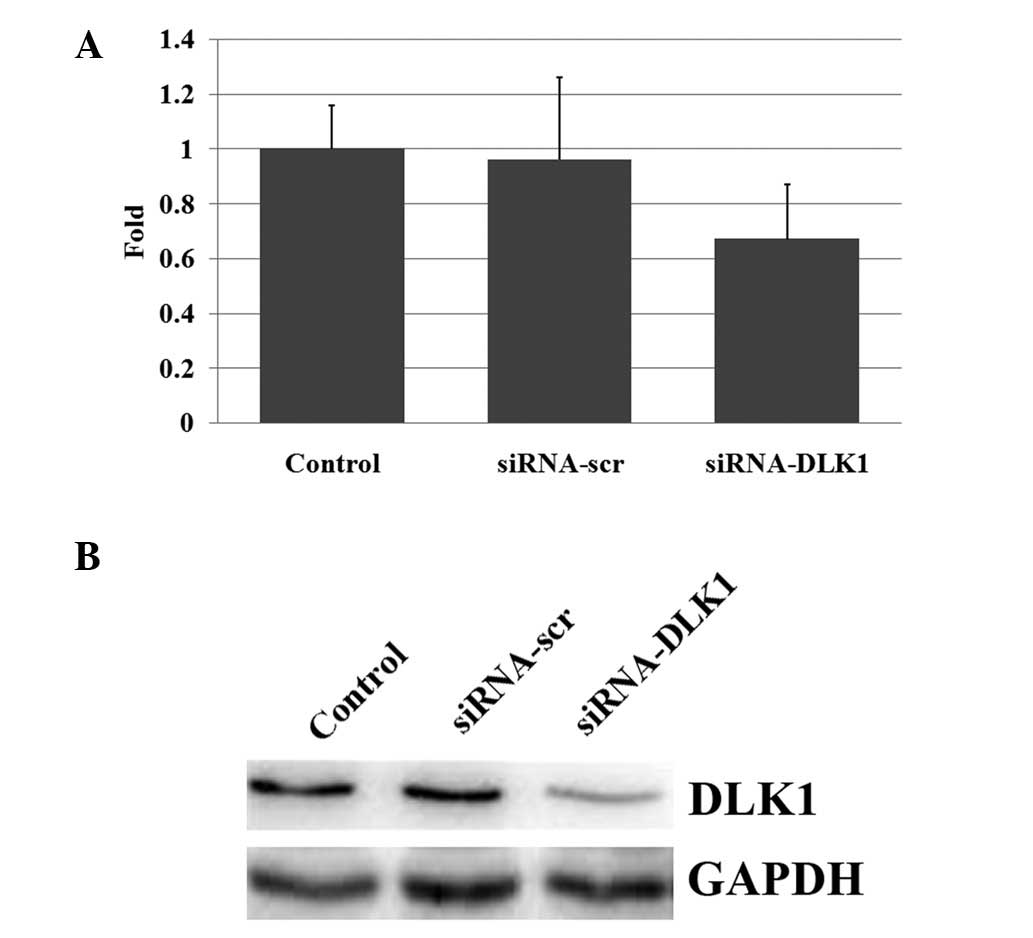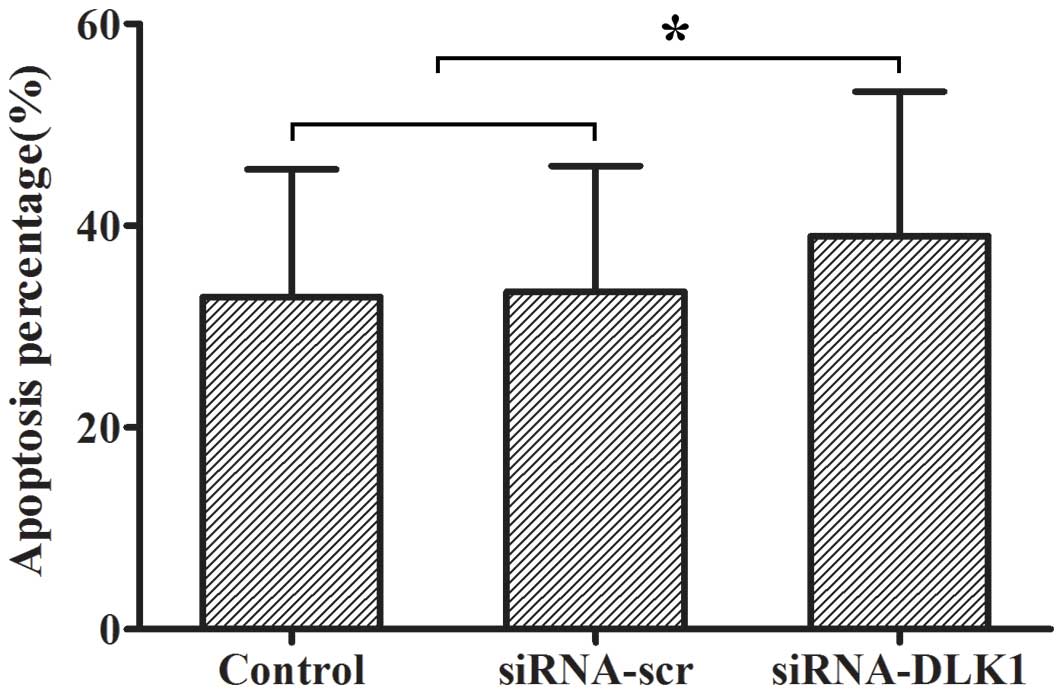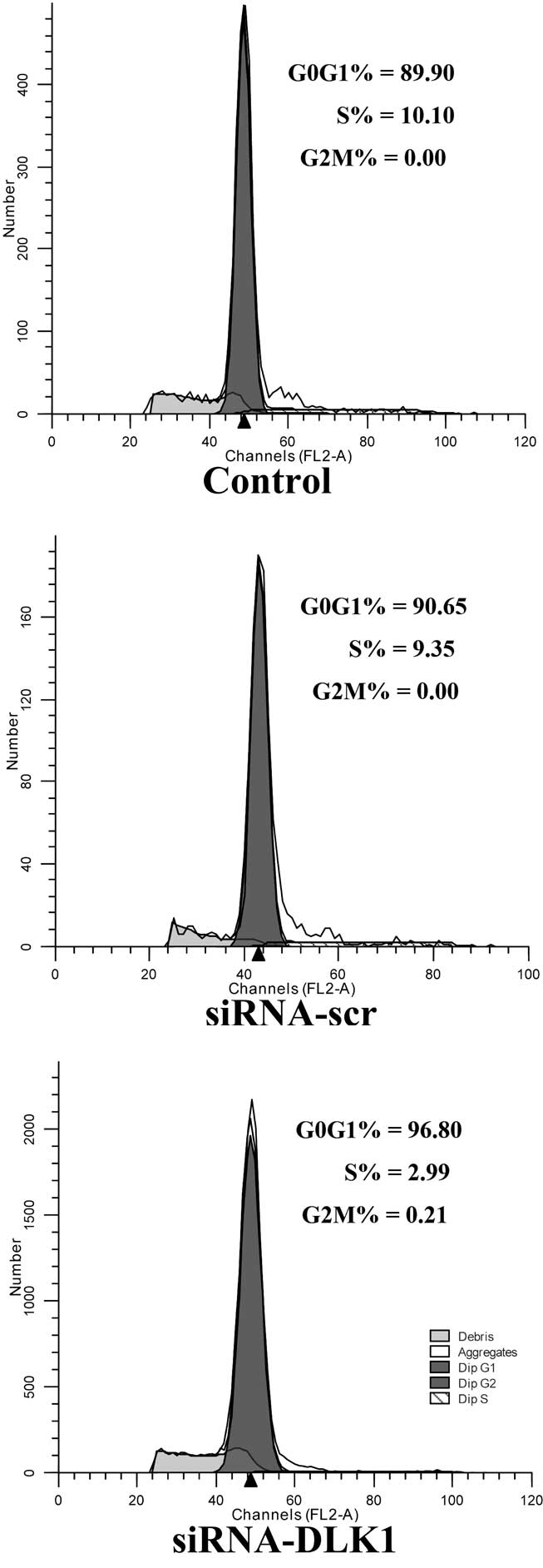Effect of DLK1 on tumorigenesis in CD34+CD38- bone marrow cells in myelodysplastic syndromes
- Authors:
- Published online on: May 14, 2013 https://doi.org/10.3892/ol.2013.1346
- Pages: 203-206
Abstract
Introduction
The myelodysplastic syndromes (MDSs) are a heterogeneous group of clonal malignant hematopoietic disorders, which are characterized by ineffective hematopoiesis and a frequent progression to acute myeloid leukemia (AML). Studies suggest that the MDSs are a group of stem-cell disorders in which aberrations within hematopoietic stem cells (HSCs) may lead to the onset of a number of diseases, including AML (1,2). Previous data have confirmed that human AML stem cells reside within the CD34+CD38− compartment of the leukemic clone, which is also observed in normal HSCs.
DLK1 is a transmembrane protein of the epidermal growth factor (EGF)-like family that mainly functions as a GF to maintain proliferating cells in an undifferentiated state (3). DLK1, also known as preadipocyte factor-1 (pref-1), fetal antigen 1 (FA1), pG2 and ZOG, is expressed extensively in immature cells and downregulated during fetal development (4), thus suggesting that DLK1 is important in stem/progenitor cells. In hematopoiesis, DLK1 is important in supporting the proliferation of early progenitor cells (5). The overexpression of DLK1 has been observed in numerous types of cancer, including MDS and AML (6,7). Evidence also suggests that DLK1 may inhibit tumor cell differentiation and increase tumorigenic potential (8), although the underlying mechanisms causing these effects remain unclear. Based on this evidence, the present study aimed to examine the hypothesis that DLK1 plays a central role in the tumorigenesis of CD34+CD38− cells. This hypothesis represents a novel perspective with regard to the differentiation of CD34+CD38− cells induced by the knockdown of DLK1 expression. This study has the potential to shed light on the role of DLK1 in CD34+CD38− cells with regard to the regulation of the cell cycle and apoptosis, and to provide mechanistic insights into the progression of malignant tumors.
Materials and methods
Patients
A total of 23 untreated patients (10 females, 13 males) who had been newly diagnosed with MDS according to the World Health Organization (WHO) criteria were enrolled in the present study (9). The median age was 56 years (range, 28–76 years). According to the WHO criteria, patients were classified as follows: refractory cytopenia with multilineage dysplasia (RCMD; including RCMD with ringed sideroblasts, RCMD-RS; n=6), refractory anemia with excess blasts-1 (RAEB-1; n=3) and RAEB-2 (n=14). Written informed consent was obtained from each patient prior to entering the trial. The study complied with the acceptable international standards outlined in the Declaration of Helsinki, and was approved by the Institutional Ethics Committee of Tianjin Medical University (Tianjin, China).
Sampling of bone marrow cells
Bone marrow was obtained from the posterior iliac crest and collected in ethylenediaminetetraacetic acid (EDTA) anticoagulated syringes. Written informed consent was obtained from each patient prior to bone marrow puncture. The bone marrow samples were transferred to the laboratory within 4 h of aspiration.
Magnetic sorting of CD34+CD38− cells
CD34+CD38− cells were obtained from the mononuclear cell fraction of the MDS bone marrow samples (Ficoll density gradient separation), followed by immunomagnetic bead selection with monoclonal murine antihuman CD34 and CD38 antibodies using the autoMACS automated separation system (Miltenyi Biotech, Mönchengladbach, Germany). The yield and purity of the positively selected CD34+CD38− cells were evaluated by flow cytometry (FACSCalibur; Bio-Rad, Hercules, CA, USA).
Cell culture and transfection
The CD34+CD38− cells were cultured in X-VIVO 10 medium supplemented with 10% fetal bovine serum (FBS) and GFs. The GF cocktail, consisting of 100 ng/ml stem cell factor (Cell Signaling Technology, Inc., Danvers, MA, USA), 100 ng/ml FLT-3 (Reprotech, Rocky Hill, NJ, USA), 20 ng/ml granulocytic CSF (Reprotech), 20 ng/ml IL-3 (Reprotech) and 20 ng/ml IL-6 (Reprotech), was used. All cultures were maintained at 37°C in a moist atmosphere containing 5% CO2. The cells were plated in 6-well plates at 2×105 cells/well. Transfection was performed using Lipofectamine 2000 (Invitrogen Life Technologies, Carlsbad, CA, USA) according to the manufacturer’s instructions. The small interfering (si)RNA sequence targeting DLK1 (siRNA-DLK1) was 5′-GCACCUGCGUGGAUGAUGAU UdTdT-3′ and 5′-dTdTAGTAGTAGGTGCGTCCACG-3′. The siRNA sequence for scrambled siRNA (siRNA-scr) was 5′-UUGAAGUUAUGUAUCCUCCUU-3′ and 5′-CUGAAG CUGCUGGGAGUAAUU-3′. Blank transfection served as the control.
Quantitative (q)PCR assay
Total RNA was prepared using TRIzol (Invitrogen Life Technologies) 48 h after transfection. The total RNA (1 μg) was reverse transcribed into cDNA using AMV reverse transcriptase (Takara Bio, Inc., Osaka, Japan) according to the manufacturer’s instructions. The DLK1 gene was amplified under the following conditions: 50°C for 2 min and 95°C for 10 min, then 40 cycles at 95°C for 15 sec, followed by 60°C for 60 sec. β-actin served as a reference. The following oligonucleotide sequences were used: DLK1 forward, 5′-CTGGACGGTGGCCTCTATGAATG-3′ and reverse, 5′-ATCATCCACGCAGGTGCCTC-3′; and β-actin forward, 5′-CACGATGGAGGGGCCGGACTCATC-3′ and reverse, 5′-TAAAGACCTCTATGCCAACACAGT-3′. Each sample was performed in triplicate and a reverse transcriptase negative control was also tested to exclude any DNA contamination. The expression ratio was calculated as 2n, where n is the CT value difference for each patient normalized by the average CT difference of the samples from the control subjects (ΔΔCT method).
Western blotting
Cell lysates were prepared on ice in radio-immunoprecipitation assay (RIPA) lysis buffer containing 50 mM Tris-Cl at pH 7.5, 150 mM NaCl, 1% Nonidet-P40, 0.5% sodium deoxycholate, 0.1% sodium dodecyl sulfate and 1–2 mM phenylmethylsulfonyl fluoride (PMSF). The protein concentrations were measured using bicinchoninic acid (BCA) assay reagents (Bio-Rad). A total of 100 μg whole cell lysate protein was separated by 10% sodium dodecyl sulfate-polyacrylamide gel electrophoresis (SDS-PAGE), and the separated protein was transferred onto polyvinylidene difluoride (PVDF) membranes. Subsequent to blocking by incubation with 5% BSA in Tris-buffered saline for 1 h at room temperature, the membrane was incubated using a polyclonal antibody against DLK1 (Cell Signaling Technology, Inc.) and an anti-GAPDH antibody (Tianjin XiangTian Technology Co., Ltd., China).
Flow cytometry
At 48 h post-transfection, the cells were collected and prepared in a suspended solution, then fixed with 250 μl solution A at room temperature for 10 min. Next, the cells were incubated with 200 μl solution B at room temperature for 10 min, followed by solution C for 10 min at 4°C in the dark. The cell cycle was analyzed using FACSCalibur flow cytometry (Bio-Rad).
At 48 h post-transfection, the cells were collected and washed with cold phosphate-buffered saline (PBS). The cells were incubated with 5 μl Annexin V and 5 μl propidium iodide (PI) at room temperature for 15 min in the dark. Cell apoptosis was analyzed using FACSCalibur flow cytometry (Bio-Rad).
Statistical analysis
SPSS 16.0 (SPSS, Inc., Chicago, IL, USA) was used to perform the statistical analysis. The data are expressed as the mean ± SD. The paired t-test analysis of variance was used to analyze the significance between groups. The least significant difference method of multiple comparisons with parental and control groups was used when the probability for the analysis of variance was statistically significant. P<0.05 was considered to indicate a statistically significant difference.
Results
Inhibition of DLK1 expression with siRNA
Following the transfection of the siRNA-DLK1, the mRNA and protein expression levels of DLK1 were inhibited. qPCR amplification revealed significantly decreased levels of DLK1 mRNA expression due to the inhibition caused by the siRNAs (Fig. 1A). A western blot analysis additionally revealed significantly decreased levels of DLK1 protein expression (Fig. 1B). Therefore, DLK1 expression was effectively inhibited by RNA interference.
Apoptosis in DLK1 knockdown cells
The rate of apoptosis was measured by flow cytometry. The apoptotic rate was increased when DLK1 expression was knocked down compared with the siRNA-scr and control groups (38.97±14.32 vs. 33.48±12.44 and 32.94±12.64%, P<0.05; Fig. 2).
Cell cycle progression in DLK1-knockdown cells
The flow cytometry assay revealed that the cells were stimulated to enter the G0/G1 phase and inhibited from entering the S phase of the cell cycle when DLK1 expression was knocked down compared with the siRNA-scr and control groups (G0/G1 phase, 95.81±3.87 vs. 91.29±10.39 and 91.22±10.82%, P<0.05; S phase, 3.90±3.61 vs. 8.41±10.33 and 8.38±10.65%, P<0.05; Fig. 3).
Discussion
The present study examined the effect of knocking down the expression of DLK1 on tumorigenesis in CD34+CD38− cells. DLK1 (pref-1) is a transmembrane and secreted protein, which is a member of the EGF-like family, homologous to Notch/Delta/Serrate. DLK-1 contains a signal peptide followed by 6 EGF-like repeats, a transmembrane domain and a short intracellular tail (3). The DLK1 gene is located within an imprinted region of chromosome 14q32 and expressed only from the paternal allele in normal cells (10). The upregulation of DLK1 has been previously observed in CD34+ cells from patients with MDS (11,12). Sakajiri et al (6) analyzed hematopoiesis in DLK1-knockout mice and suggested that DLK1 contributed to granulocyte, megakaryocyte and B-cell clonogenic growth, and was required for the generation of splenic B cells.
The elevated expression of DLK1 has been observed in several tumor types, including MDS and AML. However, the role of DLK1 and its mechanism in tumor growth remains to be fully elucidated (13). If DLK1 maintains tumor cells in a stem cell-like state, the relatively long lifespan of stem cells will allow undifferentiated tumor cells to accumulate and the stable genetic and epigenetic changes that ultimately result in tumor malignancy to be perpetuated. The role of DLK1 in tumor progression requires investigating in further detail.
The cell cycle analysis of the present study revealed that DLK1-expressing CD34+CD38− cells exhibited a slower progression through the G0/G1 phase into the S phase compared with the controls. In addition, the apoptotic rate of the CD34+CD38− cells was elevated when the expression of DLK1 was inhibited. These findings signify the importance of the DLK1 gene in inhibiting cell differentiation and reducing the rate of cellular apoptosis.
Extremely little is known about the molecular mechanism and signal transduction pathway of DLK1 that is involved in cell differentiation. Thus, these regulatory mechanisms require further investigation.
In conclusion, the present study indicates that the suppression of DLK1 expression in CD34+CD38− cells results in a less aggressive phenotype. Impaired differentiation and reduced hematopoietic cell production are important features of hematopoiesis in MDS. These results support the further investigation of the role of DLK1 in abnormal hematopoiesis in MDS.
Acknowledgements
This study was supported by grants from the Natural Science Foundation of China (30971286, 30971285 and 81170472), the Chinese Medical Association of Molecular Biology Clinical Application Research Special Funds (CAMB042010), The ‘Eleventh Five-year Plan’ National Science and Technology Support Plan (2008BA161B00) and the Health Industry Research Special Project (201002024).
References
|
Corey SJ, Minden MD, Barber DL, Kantarjian H, Wang JC and Schimmer AD: Myelodysplastic syndromes: the complexity of stem-cell diseases. Nat Rev Cancer. 7:118–129. 2007. View Article : Google Scholar : PubMed/NCBI | |
|
Nimer SD: MDS: a stem cell disorder - but what exactly is wrong with the primitive hematopoietic cells in this disease? Hematology Am Soc Hematol Educ Program. 2008:43–51. 2008. View Article : Google Scholar : PubMed/NCBI | |
|
Laborda J: The role of the epidermal growth factor-like protein dlk in cell differentiation. Histol Histopathol. 15:119–129. 2000.PubMed/NCBI | |
|
Floridon C, Jensen CH, Thorsen P, et al: Does fetal antigen 1 (FA1) identify cells with regenerative, endocrine and neuroendocrine potentials? A study of FA1 in embryonic, fetal, and placental tissue and in maternal circulation. Differentiation. 66:49–59. 2000. View Article : Google Scholar | |
|
Moore KA, Pytowski B, Witte L, Hicklin D and Lemischka IR: Hematopoietic activity of a stromal cell transmembrane protein containing epidermal growth factor-like repeat motifs. Proc Natl Acad Sci USA. 94:4011–4016. 1997. View Article : Google Scholar : PubMed/NCBI | |
|
Sakajiri S, O’kelly J, Yin D, et al: DLK1 in normal and abnormal hematopoiesis. Leukemia. 19:1404–1410. 2005. View Article : Google Scholar : PubMed/NCBI | |
|
Astuti D, Latif F, Wagner K, et al: Epigenetic alteration at the DLK1-GTL2 imprinted domain in human neoplasia: analysis of neuroblastoma, phaeochromocytoma and Wilms’ tumour. Br J Cancer. 92:1574–1580. 2005.PubMed/NCBI | |
|
Li L, Forman SJ and Bhatia R: Expression of DLK1 in hematopoietic cells results in inhibition of differentiation and proliferation. Oncogene. 24:4472–4476. 2005. View Article : Google Scholar : PubMed/NCBI | |
|
Vardiman JW, Thiele J, Arber DA, et al: The 2008 revision of the World Health Organization (WHO) classification of myeloid neoplasms and acute leukemia: rationale and important changes. Blood. 114:937–951. 2009. View Article : Google Scholar : PubMed/NCBI | |
|
Khoury H, Suarez-Saiz F, Wu S and Minden MD: An upstream insulator regulates DLK1 imprinting in AML. Blood. 115:2260–2263. 2010. View Article : Google Scholar : PubMed/NCBI | |
|
Hofmann WK, de Vos S, Komor M, Hoelzer D, Wachsman W and Koeffler HP: Characterization of gene expression of CD34+ cells from normal and myelodysplastic bone marrow. Blood. 100:3553–3560. 2002. View Article : Google Scholar : PubMed/NCBI | |
|
Pellagatti A, Cazzola M, Giagounidis A, et al: Gene expression profiles of CD34+ cells in myelodysplastic syndromes: involvement of interferon-stimulated genes and correlation to FAB subtype and karyotype. Blood. 108:337–345. 2006.PubMed/NCBI | |
|
Kim Y: Effect of retinoic acid and delta-like 1 homologue (DLK1) on differentiation in neuroblastoma. Nutr Res Pract. 4:276–282. 2010. View Article : Google Scholar : PubMed/NCBI |












